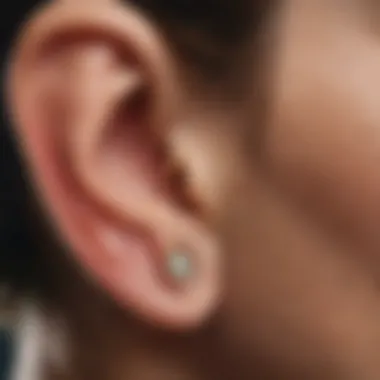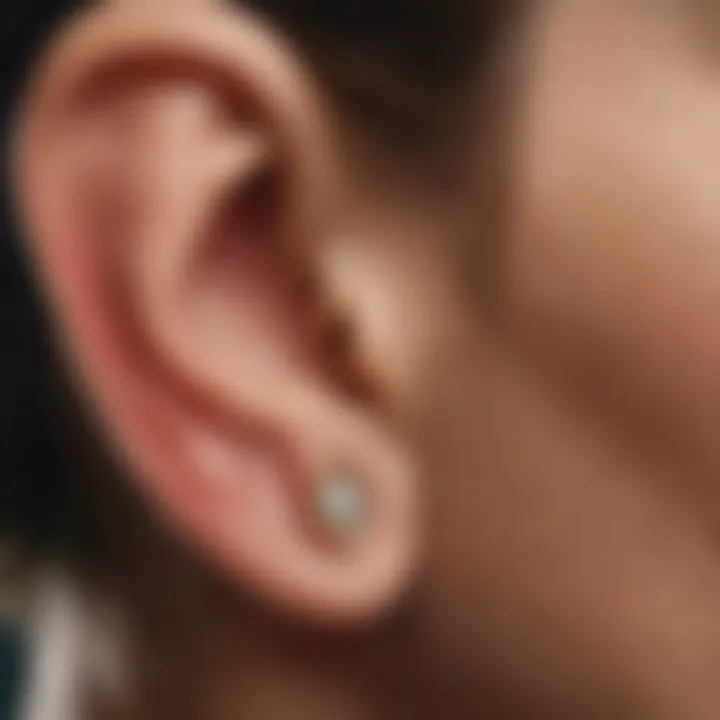Effective Methods for Removing Water from the Ear


Intro
Water trapped in the ear can be more than just a minor nuisance; it can cause discomfort and even lead to infections if not addressed properly. For athletes who engage in water activities, such as swimming, surfing, or diving, understanding this issue is crucial. Knowing how to effectively remove water from the ear should be part of any enthusiast’s toolkit. In this article, we will explore practical home remedies and professional treatments designed to help in this matter. We will also discuss the anatomy of the ear and how water gets trapped, what symptoms to watch for, and important preventative measures. Our goal is to ensure that you can safely enjoy your aquatic pursuits while maintaining optimal ear health.
Gear Recommendations
Essential Gear for Beginners
For those just starting to explore aquatic activities, having the right gear can significantly minimize the chances of water getting stuck in the ears. Here are some essential items:
- Swim Caps: They not only keep hair out of your face but also create a barrier to reduce water entry.
- Ear Plugs: Custom-fitted or silicone earplugs can be incredibly helpful in maintaining dryness while swimming or diving.
- Drying Aid Drops: Some over-the-counter products designed to evaporate moisture can be a useful addition to your gear.
These essentials set the stage for a more enjoyable experience in the water, and if you find that water still finds a way in, you will be prepared with techniques to address it.
Advanced Equipment for Professionals
For more seasoned athletes or professionals, upgrading your gear can offer increased protection. Consider investing in:
- Waterproof Headphones: While mainly for audio, they also provide hearing protection.
- High-Quality Diving Masks: A good mask prevents water from entering the ear canal entirely.
- Ear Guard: An ear guard adds extra protection during competitive swimming or diving activities.
An investment in quality gear pays dividends in peace of mind and performance.
Techniques and Tips
Practical Methods for Water Removal
Engaging with water sports, you might come across situations where water gets trapped in your ear. Here are some effective methods to help out:
- Gravity Method: Tilt your head to the side, so the affected ear is facing down. Jump or gently pull on your earlobe to help the water flow out.
- Vacuum Technique: Create a vacuum by pressing your palm tightly against your ear and quickly pulling away. This can help draw the water out.
- Rubbing Alcohol and Vinegar Mix: A few drops of a mixture of rubbing alcohol and vinegar can help dry the ear while also preventing infections.
Safety Practices and Guidelines
While it's essential to remove water from your ear promptly, safety should always come first. Here are some guidelines:
- Hygiene: Use clean hands and materials when trying to access a clogged ear to prevent introducing any bacteria.
- Avoid Q-tips: They can push water deeper into the ear or cause injury.
- Consult a Professional: If you experience pain, hearing loss, or chronic issues, it's wise to consult with an ENT specialist.
It's better to be safe than sorry. Understanding the anatomy of your ear and how it handles moisture can go a long way in preventing significant issues.
As we navigate through techniques and tips for ear water management, we'll integrate further discussions on symptoms and their implications in the next sections.
Understanding the Anatomy of the Ear
Understanding the intricate anatomy of the ear offers valuable insights into how water can get trapped within its structure. By grasping the components involved, one can take more effective preventive measures and apply the correct techniques to alleviate discomfort. The ear is not just an organ responsible for hearing; it plays a pivotal role in balancing and protecting our auditory system. Understanding how each section of the ear functions can also help pinpoint where water may be trapped and the best methods to free it.
Structure of the Ear
The ear comprises three primary parts: the outer ear, the middle ear, and the inner ear. Each section has its distinct structure and function, contributing to overall ear health.
- Outer Ear: This includes the pinna and the ear canal. The pinna acts like a funnel to collect sound waves and direct them towards the ear canal. Water can easily enter this canal, particularly during swimming or showers.
- Middle Ear: Behind the eardrum, the middle ear houses the ossicles—tiny bones essential for hearing. While this section is often protected from water entry due to the eardrum's barrier, excess pressure could lead to fluid build-up.
- Inner Ear: This part contains the cochlea and vestibular system, responsible for hearing and balance. It's less likely to be affected directly by trapped water but can feel the effects of discomfort from issues in the outer or middle ear.
By knowing these structures, you can appreciate how vulnerable the ear can be during activities like swimming or even bathing, which are common settings for experiencing trapped water.
Function of the Ear Canal
The ear canal plays several crucial roles in our ear's functioning and health. Its primary duties include:
- Sound Transmission: It directs sound waves to the eardrum, converting them into vibrations—a key step in the hearing process.
- Protection: The ear canal has hairs and earwax that prevent foreign bodies, including water, dust, and microbes, from reaching the delicate inner work of the ear.
- Humidity Regulation: The canal maintains appropriate moisture levels. An imbalance, often caused by trapped water, can lead to irritation or even infections.
In light of these functions, when water becomes trapped, it can disrupt the normal operations of the ear canal, leading to discomfort or even more serious complications. Understanding the role of the ear canal is essential for athletes and anyone engaged in aquatic activities, as it empowers them with the knowledge to manage situations where water may become trapped.
Common Causes of Water Trapping
Understanding the common causes of water trapping in the ear is crucial for both prevention and remediation. Many people, especially those who regularly participate in watersports, encounter this issue. It can lead to discomfort and even health problems, so being aware of how water can accumulate in the ears helps in taking the right steps to avoid it.
Several everyday activities can contribute to water getting stuck in the ear canal. Knowing these factors lets individuals recognize their vulnerability and take measures to mitigate them.
Swimming and Watersports
Engaging in activities like swimming, surfing, or diving can lead to water becoming entrapped in the ear. When you plunge into water, it can rush into your ears, especially if your head is tilted downwards. The ear canal’s unique shape and the presence of earwax can create an environment where water tends to stagnate, making it tricky for it to drain out naturally. *Moreover, depending on the style of swimming used, certain strokes can also cause water to splash into the ears more forcefully.
To minimize the risk, wearing snug-fitting earplugs designed for aquatics is highly recommended. These plugs create a barrier, preventing water from entering the ear canal while still allowing sound to pass through. Also, try to practice techniques that reduce splashing and excessive water intake, like adjusting your head position or breathing style when swimming.
Showering and Bathing


While swimming certainly raises the stakes, simpler everyday activities like showering and bathing can also lead to water getting trapped in the ears. Splashes from faucets, rain in the summer, and even the simple act of tilting your head to wash your hair can lead to water lurking in the ear. The risk tends to be higher for individuals who have longer hair as the wet hair can create more surfaces for trapping water close to the ear canal.
To alleviate this risk, consider wearing fitted earplugs while showering and look into adjusting the angle of your head while rinsing. Additionally, using a towel to dry off your ears afterward can help remove any residual water that might linger.
Infections and Health Conditions
In some scenarios, the accumulation of water in the ear can stem from pre-existing infections or health conditions. Ear infections, known medically as otitis media, can cause swelling and blockage of the ear canal, trapping water inside. Conditions like sinusitis can also influence ear drainage because, if the Eustachian tube becomes obstructed, it may hinder normal fluid flow.
Individuals who are prone to frequent ear infections may find themselves dealing with trapped water more often than others. This makes it paramount to consult a healthcare professional if symptoms persist or if exceeding discomfort arises. In particular, children can suffer from these issues more than adults, making vigilant care necessary for their ear health.
"Recognizing the common pitfalls that lead to water entrapment can vastly improve one’s aquatic experience, both for safety and comfort."
By being proactive and sensitive to one's activities and physical conditions, it’s possible to significantly reduce the chances of dealing with the tedious annoyance of water trapped in the ears.
Identifying Symptoms of Water in the Ear
Recognizing the symptoms of water trapped in the ear is crucial for anyone involved in activities like swimming, surfing, or even just taking a shower. When liquid becomes lodged in the ear canal, it can lead to discomfort, difficulty hearing, and even infections if not addressed promptly. Understanding these symptoms allows individuals to take proactive steps, reducing the risk of complications that could arise from prolonged water retention.
Common Signs and Symptoms
Several noticeable signs suggest that water is stuck in the ear. These may vary from person to person, but the most common indicators include:
- A sensation of fullness: Often described as a pressure feeling, it can make one feel like their ear is "plugged up."
- Muffled hearing: This might resemble the feeling of being underwater, where sounds are quieter and harder to distinguish.
- Discomfort or pain: Depending on how long the water has been trapped, a person may start to feel some level of ache or irritation.
- Tinnitus: This is the ringing or buzzing in the ear, which may occur if the water is causing irritation to the eardrum or surrounding structures.
- Fluid drainage: In some instances, you might notice a clear fluid leaking from the ear, which could indicate that the body is trying to release the trapped water.
It's important to listen to your body. If sensations such as these present themselves after a swim or shower, it's likely that water is indeed trapped.
When to Seek Medical Attention
While many people can resolve the issue of water in the ear at home, certain symptoms warrant a visit to a healthcare provider:
"Prompt medical evaluation can be the difference between a simple nuisance and a more serious health issue."
- Severe pain: If the discomfort escalates beyond moderate levels, it could signal an infection or damage to the eardrum.
- Persistent symptoms: Should signs of water retention last more than a few days without improvement, professional assessment is advisable.
- Discharge: Any discharge that is not clear may suggest an infection that requires medical intervention.
- Difficulty hearing: If muffled hearing is accompanied by other alarming symptoms, it might indicate more serious conditions that need addressing.
- Fever or systemic symptoms: Fever or other systemic symptoms alongside ear problems should never be ignored, as they may indicate a more serious infection or disease.
Identifying these symptoms and knowing when to seek help ensures individuals maintain their ear health, particularly amid frequent engagement in aquatic activities. Understanding the implications of trapped water can help you navigate potential risks and recognize when it's time to consult a professional.
Home Remedies for Ear Water Removal
When you've spent time swimming or engaged in other water activities, it’s common to feel as if you’ve got a bit of water stuck in your ear. This sensation can be annoying, and sometimes it may lead to further issues if not addressed properly. Home remedies for ear water removal are essential because they empower individuals to tackle this common predicament safely before it develops into something more serious. They provide immediate relief strategies that are both practical and cost-effective, thus giving you options without needing to run off to a doctor right away.
Gravity Techniques
These methods utilize the natural force of gravity to help dislodge trapped water from your ear canal. They are simple to implement and often yield quick results.
Tilting the Head
One of the most straightforward techniques is tilting your head towards the side of the affected ear. This method relies on gravity to assist the water in escaping from the ear canal. Paying attention to the positioning is key—leaning the affected ear downward can create a path for the trapped water to flow out.
Key characteristic: It’s incredibly simple and does not require any special equipment.
Why is it popular? Most people can do it effortlessly, anywhere and anytime, which makes it a highly favored method.
Unique features and considerations: While tilting the head is effective, it may not work for everyone. If the blockage is stubborn, further methods might be necessary. Also, it’s worth noting that if one is feeling lightheaded, moving too quickly could exacerbate the feeling.
Jaw Movements
Moving the jaw can also assist in loosening the water that’s stuck in your ear. This technique utilizes actions such as yawning or chewing, which can help shift pressure in the ear canal, facilitating the movement of trapped fluid.
Key characteristic: It efficiently utilizes the body’s natural functions for relief.
Benefit of this choice: It’s discreet and can be performed anywhere, even while chatting with friends or lounging.
Unique features and potential drawbacks: Though effective for some, this method might not work for everyone, depending on how deep the water has found its way in. Occasional discomfort may arise for those experiencing sensitive ears when exerting pressure through movement.
Use of a Towel
You can use a towel to help remove water from your ear by creating a gentle suction effect. This is done by placing the towel over the ear and tilting the head to let the fabric absorb some moisture.
Key characteristic: It’s a physical method that involves minimal risk and is generally safe.
Why it stands out: This method not only helps in absorbing some of the water but also prevents water from getting deeper into the ear if done correctly.
Unique features and considerations: Though this method may require a bit more effort to achieve noticeable results, it has the advantage of being completely safe. However, care must be taken to ensure that the towel is clean to avoid introducing bacteria into the ear.
Heat Application


Another effective method involves applying heat, which can help evaporate the water or encourage it to travel out of the ear. For example, using a warm compress against the ear can raise the temperature, easing discomfort and prompting any trapped fluid to escape.
Benefits: This method is particularly useful if the individual has a cold, as the warmth can support both tasks of clearing water and soothing a sore throat or sinus pressure. There is a comfort aspect that can’t be ignored either.
Considerations: Care should be taken not to burn the skin. A towel that’s too hot can cause injuries rather than alleviate discomfort, so moderation is key.
Over-the-Counter Ear Drops
There are various over-the-counter ear drops formulated specifically for the removal of water from the ears. These drops often contain ingredients that help break down the remaining moisture trapped inside the ear.
Benefits: They can be both effective and more precise than some other methods. They are convenient, easy to use, and can be found at most local pharmacies.
Cautions: While they work for many, it is advisable to check if there are any allergies to the ingredients listed before use. It's also worth consulting a healthcare professional if there’s any ongoing ear pain or other symptoms like discharge, which could indicate a more serious condition.
By adopting these home remedies, you provide yourself with immediate options for relief from water in the ear. Understanding their significance can aid in maintaining overall ear health, particularly for those who frequent watery environments.
Techniques Using Tools and Equipment
When dealing with water trapped in the ear, traditional methods might not suffice for everyone. This is where techniques using tools and equipment come into play. They offer reliable means to tackle the issue of water retention more effectively than just gravity tricks or home remedies. It’s crucial to understand how these tools work, their advantages, and what considerations may come into play during their use.
Bulb Syringe Method
The bulb syringe method is a time-tested approach to help relieve water trapped in the ear. It involves a small rubber bulb that functions as a suction tool—gentle yet effective in drawing out any fluid.
To begin, fill the bulb syringe with warm water or saline solution. Gently place the tip into the ear canal without inserting it too deeply; just enough to create a seal. Then, squeeze the bulb to release the fluid. The suction created during this process can dislodge the trapped water and allow it to flow out. If done correctly, you may feel a sense of relief as the discomfort subsides.
Key points to consider:
- Always opt for warm water, as cold water can lead to dizziness.
- Ensure that the bulb syringe is clean to avoid introducing bacteria into the ear.
- If you experience pain while using this method, discontinue it immediately and consult a healthcare professional.
Nasal Aspirator Usage
Nasal aspirators are often associated with helping babies clear nasal congestion, but their application in ear water removal should not be overlooked. This tool can create suction and effectively extract trapped fluid from the ear without needing to resort to more invasive methods. It’s particularly helpful for persons who frequently find themselves with waterlogged ears after activities like swimming.
To use a nasal aspirator for this purpose, follow these steps:
- Prepare: Ensure that the device is clean. If necessary, give it a rinse to ensure safe usage.
- Position Yourself: Tilt your head to the side, directing the ear with trapped water upward.
- Suction: Gently squeeze the teardrop-shaped bulb to expel air, then place the tip against the ear canal. Gradually release the bulb. The aspirator will suck in air, creating a slight vacuum that may permit the fluid to come out.
- Repeat if Necessary: If the fluid doesn't release immediately, feel free to try again a couple of times. Just ensure to give your ear a short break between attempts.
This method is particularly effective for athletes or water enthusiasts who frequently deal with this issue. However, be aware that improper use can also lead to injury, so having a gentle touch is a must.
The bottom line: Using tools like the bulb syringe and nasal aspirator can simplify the process of removing water from the ear. Just make sure to practice caution to maintain ear health.
Professional Treatments for Water Retention in the Ear
Water that stubbornly lingers in the ear can, at best, be a nuisance, and at worst, it can lead to dire consequences like infections or hearing complications. This is why understanding professional treatments for this issue is crucial. While many prefer home remedies, there’s something fundamentally reassuring about consulting a healthcare professional, especially for persistent problems. They carry the expertise that can not just alleviate discomfort, but ensure overall ear health.
Several methods exist under the umbrella of professional treatments, each tailored to different severity levels of water retention. Their benefits often outweigh potential considerations, making them a valuable option for those who find typical solutions failing.
Manual Removal Techniques
Manual removal techniques are often the first line of professional help when it comes to dealing with water lodged in the ear. This procedure usually takes place in a healthcare setting and involves a healthcare provider using specialized instruments.
- Suctioning: A doctor may apply gentle suction to create a vacuum effect—this is highly effective in dislodging stubborn water.
- Ear Irrigation: This method uses a syringe filled with warm water. The provider aims the water into the ear canal, flushing out the trapped water while ensuring the eardrum isn’t harmed. It’s a quick procedure and often yields immediate results.
- Observation and Manipulation: Skilled practitioners can sometimes reposition the patient’s head or apply movements that allow gravity to do its work. This is typically employed when the trapped water isn’t deeply lodged.
It’s worth noting that these techniques are generally safe. However, they require an experienced professional since incorrect implementation can lead to further issues, like damage to the ear canal or eardrum. Always remember—it's better to be cautious with your health than to take uncalculated risks.
Prescription Ear Drops
When water retention leads to potential infections, prescription ear drops can be a game changer. These drops often contain antibiotics or antifungal agents designed to treat any developing concerns due to trapped water.
- Antibiotic Drops: If there's a risk of bacterial infection from stagnant water, doctors may prescribe antibiotic ear drops. They work effectively to kill bacteria while also helping to reduce inflammation.
- Antifungal Treatments: For individuals prone to ear canal fungal infections, antifungal drops are an answer. These specialized drops help combat fungal growth caused by moisture retention.
- Hydrating Solutions: Some drops are designed to help facilitate the drainage of trapped water, further reducing the risk of complications. Applying these drops can make a significant difference in comfort.
Using prescription ear drops, however, comes with a couple of considerations. Patients should follow dosage instructions precisely to maximize effectiveness and minimize side effects. Also, it's best to consult a healthcare professional to determine the most suitable treatment based on individual symptoms.
"Prevention is always better than cure, but knowing where to turn when things go awry can make all the difference."
In summary, professional treatments for water retention in the ear encompass both manual techniques and medication. Engaging with a healthcare provider ensures you have access to the best options tailored to your needs while safeguarding your ear health during aquatic adventures.
Preventive Measures for Water Accumulation
Water in the ear can feel bothersome. It's like carrying a little extra weight that you never wanted in the first place. Preventing this issue is crucial not just for comfort, but for overall ear health, especially for those who find themselves frequently hitting the waves or splashing around in pools. Engaging in preventive measures can help minimize the risk of water getting lodged in the ear canal, reducing the chances of infections or discomfort in the long run.
Let’s break down some effective preventive steps that can keep your ear health in check:
Earplugs and Other Equipment


Using earplugs is one of the most straightforward preventive strategies for water enthusiasts. When you opt for earplugs designed specifically for water activities, they create a seal that stops water from entering the ear canal. There are various types of earplugs available, including:
- Silicone earplugs: Malleable and comfortable, they conform to the shape of your ear.
- Wax earplugs: Provide a snug fit, keeping water out.
- Ventilated earplugs: Allow air to circulate while blocking water, useful for those who want to listen while swimming.
Moreover, wearing a swim cap can also be quite effective. It adds an extra layer between your ears and the water, making it less likely for any O to sneak in. For recreational divers and snorkelers, a diving hood may offer more comprehensive protection against water entry.
Technique Adjustments in Watersports
When it comes to activities like swimming or jet skiing, it's not just about the gear; the techniques used can also play a significant role in keeping water out. Here are some adjustments to consider:
- Head Positioning: Keeping your head in a more upright position while diving or surfing can help minimize the chances of water entering the ear canal.
- Proper Timing: When jumping into the water, timing your entry to avoid immersing your ears immediately can prevent water accumulation.
- Breathing Techniques: When practicing breathing control, especially in activities like snorkeling, be mindful of how you inhale and exhale to maintain ear pressure, thus reducing water entry.
"Preventive care is like putting on your seatbelt before you drive—it's all about protection from unexpected situations."
Keeping all this in mind will make your time in the water more enjoyable and worry-free.
Managing Ear Health amidst Watersports
Engaging in watersports can be exhilarating and liberating; however, it also comes with the responsibility of caring for your ear health. Managing ear health amidst such activities is essential due to the unique challenges presented by water exposure.
Routine Ear Care
Establishing a routine for ear care can be your first line of defense against complications associated with water exposure in the ear. After spending time in the water, avoid using cotton swabs as they can push wax deeper into the ear canal and potentially cause blockages.
Instead, consider incorporating the following practices:
- Drying Techniques: After your aquatic activities, gently dry your outer ear with a soft towel. Leaning to the side and gently pulling on your earlobe can help the water escape.
- Ear Hygiene: Maintain cleanliness by regularly checking for earwax build-up. The right balance is crucial. Too much removal can irritate, and too little can lead to blockages.
- Regular Check-ups: Schedule ear examinations with a professional, especially if you frequently swim or are in watery conditions. They can spot potential issues before they escalate.
Recognizing Early Signs of Discomfort
The ability to recognize early signs of discomfort is vital for preventing serious complications. While the sensation of water trapped in the ears can be temporary, staying alert to other symptoms can signal deeper issues.
Be on the lookout for:
- Persistent Wet Feeling: If the feeling doesn’t go away after a short time, it may indicate a blockage or infection.
- Pain or Discomfort: Any sharp or throbbing pain should not be taken lightly. This could be a sign that something is wrong and requires attention.
- Fluid Draining: Any unusual discharge from the ear, especially if it appears yellow or green, can indicate an ear infection.
It’s better to err on the side of caution and consult with a healthcare professional if you observe these symptoms.
"An ounce of prevention is worth a pound of cure." Taking proactive steps to manage ear health can save you from extensive treatments later on.
Understanding Risks and Complications
When dealing with water trapped in the ear, it’s vital to grasp the associated risks and complications. Unaddressed water can lead to several issues, affecting not just comfort but overall ear health. Watersport enthusiasts, in particular, should recognize these complications to safeguard their hearing and prevent long-term damage.
Potential Infections
Water that lingers in the ear canal can create a prime environment for bacteria and fungi. This can result in infections such as swimmer's ear, an external ear canal infection often marked by redness, swelling, and discharge. Symptoms might include:
- Itching in the ear canal
- Fluid discharge that may appear clear or turn yellow
- Pain that can worsen when touching the outer ear
Ignoring these symptoms can lead to serious complications. In severe cases, the infection can spread, potentially invading nearby tissues and affecting the ear's internal components. It’s essential to seek prompt medical attention if symptoms develop, especially if there is significant pain or persistent fluid drainage. Regularly drying your ears and using preventive methods can go a long way to mitigate these risks.
Remember, prevention is better than cure. Keep your ear canals dry after swimming or bathing.
Impact on Hearing
Another critical consideration is how trapped water can affect your hearing. While temporary, the sensation of fullness and muffled sounds can be quite disconcerting. Prolonged exposure to moisture could also lead to conditions like conductive hearing loss, where sound waves are hindered from reaching the inner ear effectively.
Hearing fluctuations can be bothersome, especially for athletes and outdoor enthusiasts reliant on optimal auditory function for activities like diving or kayaking. Promptly addressing water retention can minimize these impacts, allowing you to return to your pursuits without prolonged disruptions. Consider implementing regular ear care practices to maintain clear auditory pathways.
Managing these risks involves a balance of vigilance and prompt action. Always be proactive in addressing water in the ears, and do not hesitate to consult a healthcare professional if complications arise.
End and Final Thoughts
In summary, addressing water retention in the ear is crucial for maintaining ear health, particularly for those who regularly engage in aquatic activities. Water trapped in the ear can lead not just to discomfort but also to serious complications if left untreated. Thus, knowing how to effectively remove water from the ear can save individuals from potential risks such as infections and impairments in hearing.
Summary of Effective Strategies
Many methods are available to help alleviate the issue of water trapped in the ear. Here’s a recap of the most effective strategies:
- Gravity Techniques: Simple tilting of the head can often dislodge the water. Similarly, gently pulling the earlobe down while tilting the head might help.
- Heat Application: Applying a warm compress can encourage the water to escape through the ear canal.
- Professional Treatments: Visiting a healthcare professional for manual removal or prescription ear drops can be necessary when home methods fail.
- Preventive Measures: Using earplugs during swimming or ensuring proper drying techniques post-bath can reduce the likelihood of water entrapment.
Moreover, these strategies serve as a reminder to respect one's ear health, ensuring enjoyment during aquatic activities without the fallout of ear discomfort.
Promoting Ear Health in Aquatic Activities
Cultivating ear health involves not only treatment but also proactive care. Athletes and enthusiasts alike should consider:
- Regular Ear Checks: Keeping an eye (or ear) out for signs of discomfort can mitigate bigger issues down the line.
- Educational Awareness: Understanding the risks and symptoms can empower individuals to act quickly when they sense water retention.
- Listening to Your Body: If discomfort persists, seeking advice from healthcare professionals should never be overlooked.
- Safe Practices: Using well-fitted earplugs, maintaining dry ears post-swimming, and making informed choices about participation in watery sports can make a significant difference.
Ultimately, being informed and acting preemptively can enhance ear health and sustain one's enjoyment of swimming and other watersports activities. Proper maintenance and care can lead to a more seamless and pleasurable aquatic experience.















